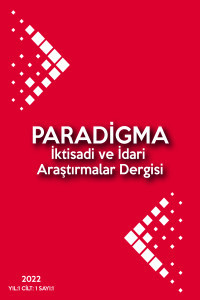İNSAN KAYNAKLARI MUHASEBESİNE İLİŞKİN DEĞERLEME MODELLERİNİN İNCELENMESİ
İnsan Kaynakları, Muhasebe
EXAMINATION OF VALUATION MODELS RELATED TO HUMAN RESOURCES ACCOUNTING
Human Resources Accounting, Valuation,
___
- A.A.A. (1973). Report of thecommittee on humanresources.The Accounting Review, 49, Committeereports: Supplementto Volume XLIX of theAccounting Review, 115-124.
- Ahmed, A. (2010). Human resourceaccounting (HRA): Techniquesandaccountingtreatment.InclusiveBangladesh Development Foundation; TheInstitute of CharteredAccountants of Bangladesh (ICAB), 1-14.
- Akinsoyinu, A. B. (1992). Human resourcesaccounting: Themythandreality. TheNigeriaAccountant, 18-20.
- Arkan, T. (2016). Human resourcesaccounting: A suggested model formeasurementandvaluation. Finanse, RynkiFinansowe, UbezpieczeniaCzasopismo, 1(79), 173-193.
- Brummet, R.L.,Flamholtz, E. G. &Pyle, W. C. (1968). Human resourcemeasurement: a challengeforaccountants. Accounting Review,XLIII, 217-224.
- Cherian, J.,&Farouq, S. (2013). A review of humanresourceaccountingandorganizationalperformance. International Journal of Economicsand Finance,5(8),74-83.
- Ciprian, G.G. (2007). Socialaccountingto maket thesocialresultsvisible.
- Dawson C. (1994). Theuse of a simulationmethodologytoexplorehumanresourceaccounting. Management Decision, 32(7). 46-52.
- Ezeagba, C. E. (2014). Theneedforinclusion of humanresourcesaccounting in thebalancesheet. An International MultidisciplinaryJournal,8(2),377-392.
- Flamholtz, E.G. (1974). Human resourceaccounting. California: Dickenson Publishing.
- https://businessdocbox.com(2018)./Human_Resources/71408305-Chapter-3-an-overview-of-models-of-hra.html on 01.04.2018
- Ibarra, V. C.,&Cosico, C. A. (2016). Awareness ofhumanresourceaccountingpracticesandcosting: evidencefromthePhilippines. Global Journal of Business Research, 10(4),27-42.
- Ijeoma, N.,Bilesanmi, A. O., &Aronu, C. O. (2013).Determiningthecontribution of humanresourceaccounting (HRA) on financialstatement of nigerianbanksusingthemantel test analysis. International of Scientific&Technology, 2(10),51-55.
- Kashive, (2002).Importance of humanresourceaccountingpracticesandimplications of measuringvalue of humancapital: casestudy of successfulPSUs in India. XIMB Journal of Case Research 4(2).113-144.
- Kaya, U. (2013). İnsan kaynakları muhasebesi (1.Baskı). İstanbul: Beta Yayınları.
- Nisamudheen, T.,&Mufliha, S. (2016). Human resourceaccountingandauditing. United States: LuluPublication.
- Oluwatoyin, A. S. (2014). Human resourcesaccountinganddisclosure in financialstatement: literaturereview. ResearchJournal of Finance and Accounting, 5(22),64-75.
- Rajsheka, V. (2018). http://shareyouressays.com/knowledge/top-4-methods-used-to-measure-human-resource-in-your-organisation-explained/94579, 21.11.2018.
- Saremi, H.,&Nagshbandi, N. (2012). Impact of humanresourcesaccounting on employees’ performance in organization. International SciencePress, 5(2),199-229.
- Shodganga. Retrieved from http:// shodhganga. inflibnet.ac.in/bitstream/ 10603 /148281/8/08 _chapter%202.pdfon 05.05.2018
- Siegel, J.I.,& G., Shim, J. K. (2005). Dictionary of accountingterms(4th ed.).America: Barron’sEducational Series, Inc.
- Singh, A. (2010). Human resourceaccounting at infosys – a casestudy. 262-273.
- Srivastava, N. (2014). Human resourceaccounting: a strategicaproachtocorparateexcellence. International JournalforResearch in AppliedScienceandEngineeringTechnology, 2(4). 423-428.
- Yadav, S.,College, R., &Prakash, A. (b.t.) Human resourcemanagement. Institute of Lifelonglearning, University of Delhi.
- Yayın Aralığı: Yılda 2 Sayı
- Yayıncı: Gümüşhane Üniversitesi
PERFORMANS ESASLI BÜTÇELEME: AMERİKA BİRLEŞİK DEVLETLERİ (ABD), FRANSA VE TÜRKİYE ÜLKE DENEYİMLERİ
Suat Hayri ŞENTÜRK, Kadir Caner DOĞAN
THE EFFECT OF POLITICAL IDENTITY DEFINITION ON ISLAMIC FINANCE PERCEPTION IN TURKEY
TÜRKİYE’DE TURİZM, FİNANSAL GELİŞME VE EKONOMİK BÜYÜME ARASINDAKİ İLİŞKİ
Hasan AYAYDIN, Nuri BALTACI, Fahrettin PALA, Abdulkadir BARUT
Didem KUTLU, Hasan AYYILDIZ, Nilgün KANER KOÇ
UZLAŞMANIN VERGİYE GÖNÜLLÜ UYUMA ETKİSİ:ANKARA’DAKİ SMM, YMM VE SM’LER ÜZERİNE BİR UYGULAMA
Abdulkerim DAŞTAN, Yaşar BAYRAKTAR, Uğur BELLİKLİ
Onur İZMİR, Ahmet Burak TURGUT
THE ROLE OF MACROECONOMIC INDICATORS ON STOCK INDEX EVIDENCE FROM TURKEY
Abdullah Ferit EROL, Sinan AYTEKİN
İNSAN KAYNAKLARI MUHASEBESİNE İLİŞKİN DEĞERLEME MODELLERİNİN İNCELENMESİ
